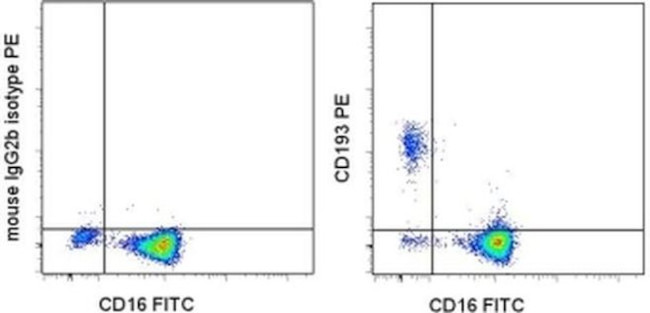Search Thermo Fisher Scientific
Invitrogen
CD193 (CCR3) Monoclonal Antibody (eBio5E8-G9-B4 (5E8-G9-B4)), PE, eBioscience™
FIGURE: 1 / 1
CD193 (CCR3) Antibody (12-1939-42) in Flow

Product Details
12-1939-42
Species Reactivity
Published species
Host/Isotype
Recommended Isotype Control
Class
Type
Clone
Conjugate
Excitation/Emission Max
Form
Concentration
Purification
Storage buffer
Contains
Storage conditions
Shipping conditions
RRID
Product Specific Information
Description: The eBio5E8-G9-B4 monoclonal antibody reacts with human CD193 (CCR3, CKR3). CD193 is a member of the seven transmembrane G-protein coupled receptor (GPCR) family, and is a high affinity chemokine receptor for the chemokines eotaxin-1 (CCL11), eotaxin-2 (CCL24), eotaxin-3 (CCL26) and MCP-4 (CCL13), but has also been reported to bind RANTES, MCP-3 and MCP-4. CD193 is highly expressed on the surface of eosinophils, and is the key eosinophil chemokine receptor responsible for the regulation of eosinophil migration and function. In addition to eosinophils, CD193 is also expressed on CD4+ TH2 cells, basophils, mast cells, mononuclear phagocytes, platelets, CD34+ hematopoietic progenitors and airway epithelial cells. CD193 likely plays an important role in the migration of eosinophils in allergic airway inflammation and asthma. CD193 can also serve as a receptor for HIV-1 cell entry.
Applications Reported: This eBio5E8-G9-B4 (5E8-G9-B4) antibody has been reported for use in flow cytometric analysis.
Applications Tested: This eBio5E8-G9-B4 (5E8-G9-B4) antibody has been pre-titrated and tested by flow cytometric analysis of normal human peripheral blood cells. This can be used at 5 µL (0.06 µg) per test. A test is defined as the amount (µg) of antibody that will stain a cell sample in a final volume of 100 µL. Cell number should be determined empirically but can range from 10^5 to 10^8 cells/test.
Excitation: 488-561 nm; Emission: 578 nm; Laser: Blue Laser, Green Laser, Yellow-Green Laser.
Filtration: 0.2 µm post-manufacturing filtered.
Target Information
CCR3 (C-C chemokine receptor type 3) binds to eotaxin, eotaxin-3, MCP-3, MCP-4, RANTES, and MIP-1 delta. CCR3 trasnduces a signal by increasing the intracellular calcium ions level. It also serves as an alternative co-receptor with CD4 for HIV-1 infection. Other chemokines play important roles in inflammation and are critical for the recruitment of effector immune cells to sites of infection. Chemokines activate leukocytes by binding to G protein coupled receptors. The ever-growing chemokine receptor subtypes can be divided into 2 major groups, CXCR and CCR, based on the 2 major classes of chemokines.
For Research Use Only. Not for use in diagnostic procedures. Not for resale without express authorization.
How to use the Panel Builder
Watch the video to learn how to use the Invitrogen Flow Cytometry Panel Builder to build your next flow cytometry panel in 5 easy steps.
Bioinformatics
Protein Aliases: b-chemokine receptor; C C CKR3; C-C chemokine receptor type 3; C-C CKR-3; CC chemokine receptor 3; CCR-3; CD193; chemokine (C-C motif) receptor 3; eosinophil CC chemokine receptor 3; Eosinophil eotaxin receptor; MGC102841
Gene Aliases: CC-CKR-3; CCR3; CD193; CKR3; CMKBR3
UniProt ID: (Human) P51677
Entrez Gene ID: (Human) 1232

Performance Guarantee
If an Invitrogen™ antibody doesn't perform as described on our website or datasheet,we'll replace the product at no cost to you, or provide you with a credit for a future purchase.*
Learn more
We're here to help
Get expert recommendations for common problems or connect directly with an on staff expert for technical assistance related to applications, equipment and general product use.
Contact tech support

